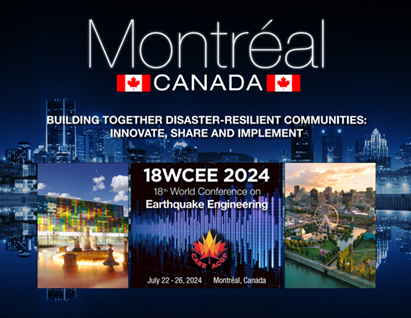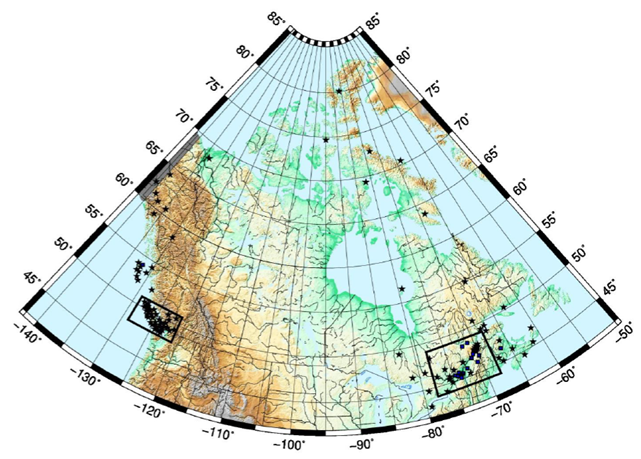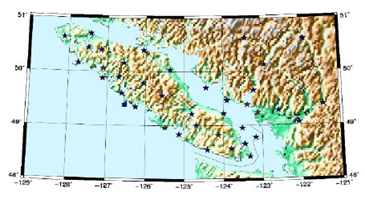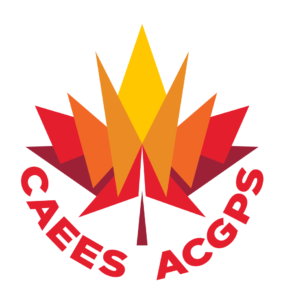 From the Editor’s Desk
From the Editor’s Desk
by Tuna Onur
Recent large earthquakes in Alaska and Turkey remind us to stay vigilant about earthquake and tsunami risk and work towards reducing risk to our communities.
The pandemic continues to impact the globe and many earthquake engineering conferences have gone fully or partially online. We continue to provide links to a variety of online conferences, courses, and webinars in our Newsletter.
We also highlight in this issue some important Canadian sources of strong ground motion data in our Earthquake Waves column.
We hope everyone is staying healthy as the fall seems to bring a spike in COVID-19 cases, and as always, we encourage you to share short articles, news or other items related to earthquake engineering. Please send your contributions to [email protected]
More Webinars
Upcoming Live Webinars and Workshops:
EERI Webinar: Next Steps for Earthquake Preparedness in the San Diego Community:
Nov 13: This webinar will focus on how to prepare for disasters, looking at outreach, developing a group of stakeholders, and identifying short-term and long-term goals for San Diego.
USGS National Seismic Hazard Mapping Project (NSHMP) Workshop – Pacific Northwest Fault Model:
Nov 17: In this workshop, draft updates to the USGS Fault Model for Pacific Northwest will be presented and discussed. A key goal of these workshops is to solicit feedback on the updates to the fault geometries and the geologic slip rate database.
www.usgs.gov/natural-hazards/earthquake-hazards/nshmp-workshops
Haywired Volume 3 Event: Modeling Economic Impacts of Earthquakes – Research and Practice:
Nov 19: The workshop focuses on how modeling of economic impacts of disasters can inform policy-making and planning at the city, county, and regional levels in the San Francisco Bay Area.
jointventure.org/images/stories/pdf/HayWired_111920_modeling_webinar.pdf
Pre-recorded Webinars and Conference Presentations:
Earthquake Country Alliance (ECA) Safer at Home Webinar Series:
This seven-webinar series presents simple steps everyone can take to be safer at home.
www.earthquakecountry.org/safer-at-home/
2020 National Earthquake Conference and 72nd EERI Annual Meeting in San Diego, US:
Presentations from this Conference can be found in the link below. Scroll down and keep an eye out for little red boxed that are marked “download presentation”:
Montreal’s Bid for 18WCEE 2024
by Ghyslaine McClure
Dear colleagues and supporters of the 18 WCEE Canadian bid,
The Canadian bid to host 18WCEE 2024 has been submitted!

On September 30th, Sharlie Huffman, the President of the CAEE, submitted our bid documents to the International Association for Earthquake Engineering (IAEE), in preparation for the online vote by national delegates. The vote window is October 15-November 15 and Sharlie will be informed of the results in November.
You may access the full proposal (PowerPoint presentation, comprehensive bid document, and videos) using the following links:
18WCEE 2024 Canada Web site: congresmtl.com/en/wcee-2024/
Video presentation: vimeo.com/462012934
Full bid document: www.congresmtl.com/Communications/Bids/WCEE2024/eBid_WCEE2024.pdf
High-resolution PowerPoint presentation: www.congresmtl.com/Communications/Bids/WCEE2024/EarthQuake2024_PPT_Hires.pdf
This project has been a true team effort involving so many collaborators and supporters, and we are grateful to each and all of you who have contributed to the proposal in many different ways, sharing material, photos, providing permission to use your company logos, sending encouraging e-mails, etc. We also want to acknowledge the incredible technical support provided by the Palais des Congrès team, led by Marc-André Gemme and Maude Lagacé.
We trust that you are as excited as we are at the prospect of hosting the Conference in Montreal in July 2024, and hope for the best possible vote outcome!
Stay safe!
Ghyslaine McClure, on behalf of the Local Organising Committee
Sharlie Huffman, CAEE President
Earthquake Waves
by John Cassidy
As there have been no significant Canadian earthquakes during the past few months, this column will highlight something completely different… rather than an earthquake, I discuss the recently updated strong motion component of the Canadian National Seismograph Network (CNSN).
As of September 2020, one of the most significant changes in strong motion monitoring in Canada since the first deployment of accelerometers in 1963, has been largely completed. This upgrade provides ~100 new strong motion instruments (Nanometrics Titans) co-located with weak-motion instruments (6-component) at CNSN bedrock sites with an additional ~40 sites (mostly bedrock, but some soil sites also) having stand-alone strong motion instruments.
The vast majority of these CNSN instruments (see maps below – squares represent “strong motion only” sites and stars are “6-component” sites) are located in the high seismic hazard regions of Canada, especially Vancouver Island and southwest British Columbia (BC), Haida Gwaii, and the St. Lawrence Valley region. Also, for the first time, strong motion instruments are located in northern Canada. For some details, see the CNSN Station Book at: earthquakescanada.nrcan.gc.ca/stndon/CNSN-RNSC/stnbook-cahierstn/index-en.php
See the following page for zoomed in maps for southwest BC and St. Lawrence Valley.



The Titans are currently streaming data at 100 samples/sec and have a maximum 4 g recording level. The continuous records from the Titan sensors are available by request to the NRCan’s National Waveform Archive. It is intended that higher sample rate streams will be implemented in some locations, with the understanding that the data will be stored in the digitizer for later request, and not streamed because of bandwidth costs.
To ensure high availability and resiliency, all seismic data are sent simultaneously to two data centers: one in Sidney, British Columbia and one in Ottawa, Ontario. The acquisition systems forward the data to an archive server, where the data are saved and available to the routine processing systems.
Strong motion waveform data and station metadata are freely available via a variety of methods – see: earthquakescanada.nrcan.gc.ca/stndon/wf_index-en.php
or contact: [email protected]
Note that all CNSN waveform data are forwarded to the Incorporated Research Institutions for Seismology Data Management Center (IRIS-DMC) in real time and can be easily accessed via: ds.iris.edu/ds/nodes/dmc/data/types/waveform-data/
Simple ASCII format files are available from this IRIS website. Another advantage of this data centre is that pre-assembled waveform data for significant events (e.g., through the “Wilbur” option) are available, including seismic data from a variety of networks.
In addition to these strong motion instruments (that are mainly located on bedrock) there are an additional 350+ strong motion instruments across Canada (most located in British Columbia) that are owned and operated by other organisations (e.g., British Columbia Ministry of Transportation and Highways, BC Hydro, and more). These instruments are primarily located on soil sites. For more information (and data access) on many of these sites in British Columbia, see:
With the recent CNSN upgrade, and the continued expansion of strong motion monitoring by other organisations across Canada, engineers will have access to more (and very valuable) strong motion data from Canadian earthquakes. This will lead to improved earthquake hazard models, improved seismic design for infrastructure, and safer communities.
CAEE
Dept. of Civil Engineering
Univ. of British Columbia
2324 Main Mall
Vancouver, BC,
Canada V6T 1Z4
Fax:604-822-6901
E-mail:[email protected]
We’re on the Web!
Visit us at: https://caee.ca
News
EERI Releases Earthquake Spectra Special Issue on GEM’s 2018 Global Hazard and Risk Models
The special issue was released in October and it documents the supporting research critical to the development of the Global Seismic Hazard and Risk models by the GEM (Global Earthquake Model) Foundation, representing a major step in understanding earthquake risk globally.
Seismic hazard and risk models are needed for accurate assessment of earthquake risk in order to promote and inform risk reduction and mitigating actions, such as the improvement of building codes and construction practices, land use planning, emergency response, protection of critical infrastructures, and risk transfer through insurance.
News and Upcoming Events
Due to COVID-19 pandemic, many conferences and workshops have been cancelled, postponed or converted to online events globally. We provide information on events available this quarter.
For additional upcoming live webinars and pre-recorded events available online, please see pages 1 and 2.
Upcoming events
2020 Understanding Risk BC
August – November 2020
online
https://www.urbc.ca/
IABSE Conference Christchurch 2020: Resilient Technologies for Sustainable Infrastructures
3-5 February 2021
Christchurch, New Zealand
https://iabse.org/Christchurch2020
2021 EERI Virtual Annual Meeting
23-25 March 2021
www.eeri.org/2020/09/2021-eeri-annual-meeting-call-for-session-proposals/#
2021 SSA Annual Meeting (Online)
19 – 23 April 2021
www.seismosoc.org/annual-meeting/
37th General Assembly of the European Seismological Commission
19 – 24 September 2021
Corfu, Greece
www.escgreece2020.eu/
17th World Conference on Earthquake Engineering
27 September – 2 October 2021,
Sendai, Japan
http://www.17wcee.jp/
